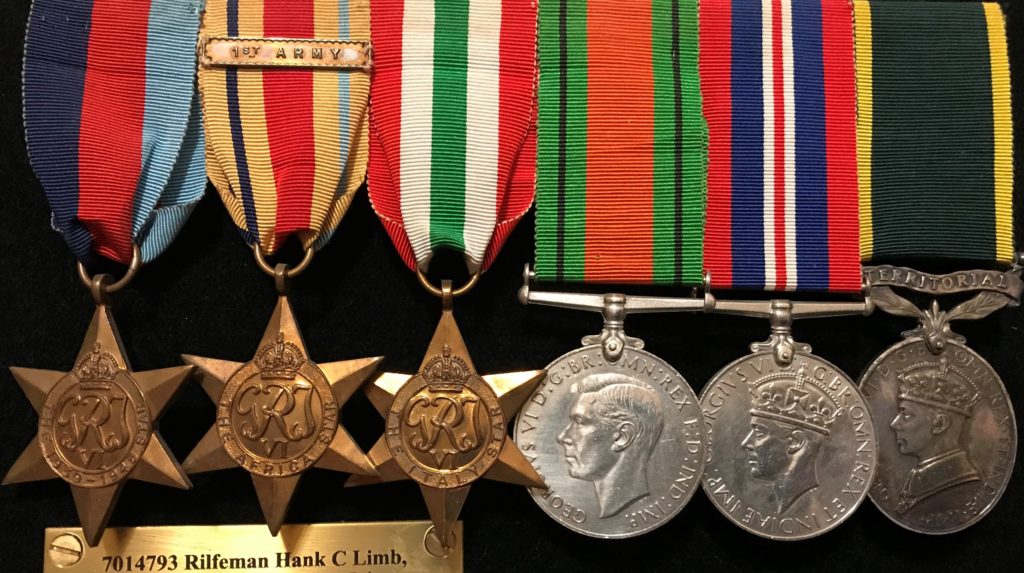Shown below is a typical medal group awarded to the London Irish Rifles for 1939-1945 service. The medal ribbons were reportedly designed by King George VI and all have symbolic significance. Traditionally all British issued medals are named to the recipient, usually around the rim, but tragically none of the British issued Service medals or Stars were named for the Second World War set (Australia and South Africa did name theirs) so it is pleasing to see a named Territorial Efficiency Medal or a General Service Medal in a Second World War group so the person’s identity and unit can be verified. The LIR grew in size from one Battalion to two during the first part of 1939 with many men joining when the LIR were still technically a Territorial Unit and as such a large percentage of Second World War veterans qualified for their TA Efficiency Medal.

Naming in the captioned example is as follows ‘7014793 RFN. H.C. LIMB. R.U.R. L.I.R’
The 1939-1945 Star
Awarded to any serviceman for at least six months’ service in a theatre of war between 3rd September 1939 and 2nd September 1945 (death, injury, capture, decoration or Mentioned in Despatches during the 6 months qualified you immediately). It is made of bronze with a loop for the ribbon. A six pointed star with a centre Royal Monogram topped with a crown inscribed ‘The 1939-1945 Star’ and has a plain reverse. The ribbon represents the three Services – Navy: Blue, Army: Red and RAF: Blue.
The Africa Star
Awarded to any serviceman for at least one day of service in North Africa between 10th June 1940 and 12th May 1943 (ie starting from Italy’s declaration of war up to the end of Operations in N Africa). It is made of bronze with a loop for the ribbon. A six pointed star with a centre Royal Monogram topped with a crown inscribed ‘The Africa Star’ with a plain reverse. The ribbon is buff yellow representing the desert sand with the three Service colours stripes. Clasp ‘1st Army’ was awarded for service between 8th November 1942 and 12th May 1943 with the 1st Army of which the 2nd Battalion of the LIR formed part.
The Italy Star
Awarded to any serviceman for at least one day of service in Italy (including Corsica, Yugoslavia and Greece) between 11th June 1943 and 8th May 1945. It is made of bronze with a loop for the ribbon. A six pointed star with a centre Royal Monogram topped with a crown inscribed ‘The Italy Star’ and has a plain reverse. The ribbon is representative of the Italian flag.
The Defence Medal
Awarded to a large variety of uniformed personnel from Air Raid Precautions personnel, Home Guard, Firemen, Policemen etc as well as Service Personnel. A most underrated medal issued unnamed to millions of uniformed men and women who served their country when Britain stood alone. For service in the UK, the qualification was three years (again when you think of the ferocity of the London and Belfast Blitz, this was a hard won medal) For Service Personnel, qualification was 6 months in a war zone. It is made of cupro-nickle with a straight suspender for the ribbon. The obverse is an uncrowned King George VI with the reverse bearing two lions flanking a crowned oak sapling with the dates ‘1939-1945’ and ‘The Defence Medal’. The ribbon is green representing our green and pleasant land with a centre stripe of orange representing the flames and two black stripes representing the blackout.
The War Medal 1939-1945
Awarded to all full time personnel of the armed forces for 28 days’ uniform service. It is made of cupro-nickle with a straight suspender for the ribbon. The obverse is a crowned King George VI with the reverse bearing a triumphant lion trampling a dragon (symbolising the Axis powers) with the dates ‘1939-1945’. The ribbon has a central red stripe with white, blue and red on either side.
The Territorial Efficiency Medal
Awarded to Territorial Soldiers for 12 years’ service with war service counting double (i.e. after 6 years’ service). It is an oval silver medal with an ornate palm leaf suspender with the words ‘Territorial’ in a scroll below the ribbon. The obverse is a crowned King George VI with the reverse bearing the inscription ’For Efficient Service’. The ribbon is green with yellow edges. The naming is in impressed capitals around the rim of the medal. As it is oval the naming is sometimes slightly off centre.
Lt Col Ant Maher, courtesy of The Emerald.